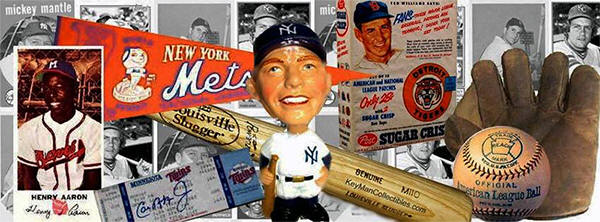|
Nineteenth
century woodworking shops joined
Sorting Goods companies to meet the
growing demand for baseball bats.
Some, like J. F. Hillerich & Son
were successful. Others, such as
horse and buggy manufactures, made
baseball bats to supplement their
business during changing times.
Twentieth century tool handle companies, furniture manufactures, or any
business with a lathe, turned out
baseball bats, to generate extra
income during tough times, as
brought on by the Great Depression.
Manufactures supplied privately
branded baseball bats bearing the
the name of hardware, department,
or sporting goods stores, resulting
in 100's of brands.
|
|
| |
 |
|
| |
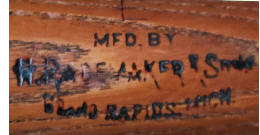 Before
J. F. Hillerich & Son entered the
baseball bat market there was
H. Rademaker & Sons; a wholesale
manufacturer of baseball bats, croquet
sets, and all kinds of turned goods.
They became the largest manufacturer of
baseball bats in the world by 1896. Before
J. F. Hillerich & Son entered the
baseball bat market there was
H. Rademaker & Sons; a wholesale
manufacturer of baseball bats, croquet
sets, and all kinds of turned goods.
They became the largest manufacturer of
baseball bats in the world by 1896.
It was reported that the company turned out 200,000 baseball bats in 1887
alone. The crude reverse branding on
this bat suggests that it was made
earlier than the bats illustrated in
1885 advertisements. There is no
evidence that the company made bats
with the H. Rademaker & Sons label,
after 1896, but the company is listed
in the 1921 Sporting goods Trade
Directory as a bat manufacture. H.
Rademaker & Sons continued to
manufacture croquet sets into the
1960s.
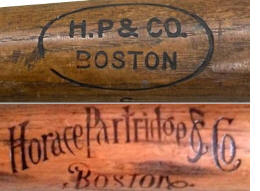 H. Partridge & Co. Fancy Goods, was
established in 1847 by Horace
Partridge. The wholesale company sold
dolls, toys, musical instruments and
games. In 1880 the company's name was
changed to
Horace Partridge & Company.
Baseball bats that are branded with
'H.P. & Co.' or 'Horace Partridge &
Co.' were made before 1908, 'H.P. Co.
bats were manufactured in 1908, or
later.
H. Partridge & Co. Fancy Goods, was
established in 1847 by Horace
Partridge. The wholesale company sold
dolls, toys, musical instruments and
games. In 1880 the company's name was
changed to
Horace Partridge & Company.
Baseball bats that are branded with
'H.P. & Co.' or 'Horace Partridge &
Co.' were made before 1908, 'H.P. Co.
bats were manufactured in 1908, or
later.
The 1918 Horace Partridge Company
catalog makes the statement; the
company "made arrangements with the
leading bat manufacturers of the
country for their first selection of
stock." The players associated to
each bat were under contract with
the Hillerich & Bradsby Co., and
Louisville Slugger baseball bats are
also listed in the catalog, suggesting
that Hillerich & Bradsby Co. produced
the bats for Horace Partridge.
|
|
| |
|
|
| |
 |
|
| |
James N. Zimmerman started his
business in Birmingham, Mich., in
1896, producing such products as; axe
handles, neck yokes, Indian clubs, and
baseball bats. then in 1905 moved to Owosso, and founded
the
Zimmerman Manufacturing Company.
Known as the Zimmerman Bat Co., the
buuisness Incorporated in 1920, as the Zimmerman MFG
Co.
The bat business was then purchased by the Louisville Slugger Company, and
Zimmerman continued to manufacture
handles of various kinds and special
turnings. When the contract with
Louisville Slugger ran out, Zimmerman
began making bats for the local market.
The "J.N. Zimmerman" cross bat branding was a safe Hit model with a
Christy Mathewson signature
endorsement. This bat might have been
made after Zimmerman signed a contract
with Louisville Slugger in 1920. In
1930, Zimmerman moved his business to
Corunna, |
|
| |
|
|
| |
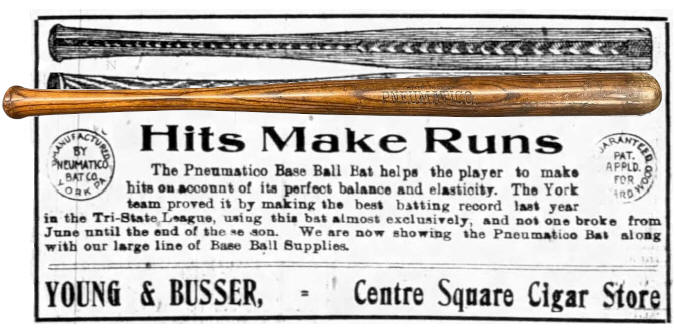 |
|
| |
The
Pneumatico Baseball Bat was the brainchild of Charles P. Young, a
prominent business man of York, PA, and
a senior member of the firm of Young
and Busser, Centre Square cigar store.
Young applied for a patent for the
Pneumatic baseball bat, which had a
hollow air-filled core to help the
player "make hits on account of its
perfect balance and elasticity."
There are no records that the patent was approved, but Young secured the
trademark for the word "Pneumatico,"
which was used or the center brand. The
knob on the bat was branded in white;
"Manufactured by Pneumatico, Bat Co.
York, PA." |
|
| |
|
|
| |
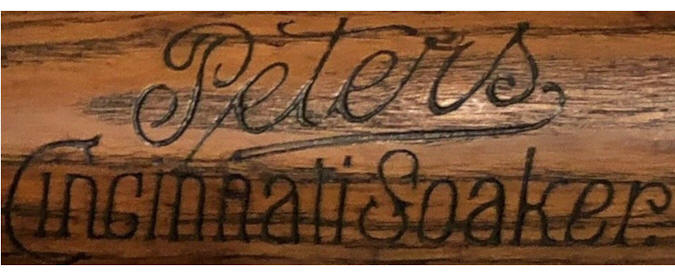 |
|
| |
The Peters Arms and Sporting Goods Co. was a wholesale dealer that
carried a full line of fire arms,
athletic and general sporting goods.
Founded by Orin E. Peters, then
president of the Peters Cartridge Co.,
in 1900, Peters closed down his short
lived sporting goods company in 1908,
because of heath issues.
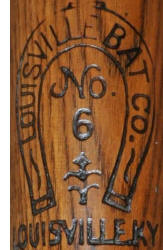 There's not much information available
about the
Louisville Bat Company. The
1906 Bigelow & Dowse Co. hardware
catalog lists the Louisville Bat Co.
bats under the name, J.F. Hillerich &
Son, suggesting that Louisville Slugger
owned the company at the time.
There's not much information available
about the
Louisville Bat Company. The
1906 Bigelow & Dowse Co. hardware
catalog lists the Louisville Bat Co.
bats under the name, J.F. Hillerich &
Son, suggesting that Louisville Slugger
owned the company at the time.
J.F Hillerich & Sons, would sometimes acquire the plants of small bat
manufacturers, to increase production
of their own brand of baseball bats. In
some cases, they continued to
manufacture the brand they purchased
for a number of years after. The
Louisville Bat Co. horseshoe label was
still being produced into the 1920s.
It's not until the 1950s, when the Louisville Bat Co. name resurfaces, but
without the horseshoe logo. The model
No. 100J, Louisville Bat Co. baseball
bat, featured a Louisville Slugger like
center brand, with the
Hilton Collins "Louisville Mascot"
trademark name above. Block
letter player endorsements under
contract with Louisville Slugger
include; Joe DiMaggio, Johnny Mize,
Stan Musial, and Ted Williams.
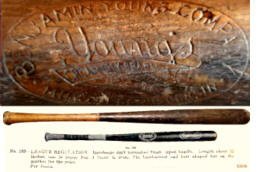 The Benjamin Young Company was a
addlery company that operated around
1897 to 1918 in Milwaukee Wisconsin. In
1916 the Perkins-Campbell co. purchased
Benjamin Young but still retained the
name. Their 1916 wholesale catalog
included; Harnesses, horse collars,
general saddlery, leather novelties,
carriage and automobile robes, and
Sporting goods.
The Benjamin Young Company was a
addlery company that operated around
1897 to 1918 in Milwaukee Wisconsin. In
1916 the Perkins-Campbell co. purchased
Benjamin Young but still retained the
name. Their 1916 wholesale catalog
included; Harnesses, horse collars,
general saddlery, leather novelties,
carriage and automobile robes, and
Sporting goods.
The
Benjamin Young's Cream City Brand
Baseball Bats were manufactured by
J.F. Hillerich & Son Co., and the
decals used on the Benjamin Young
baseball bats are the same used on
Louisville Slugger bats.
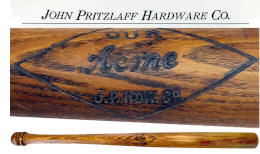 This
"Our Acme J.P. HDW. Co." branded
baseball bat was made for the John
Pritzlaff Hardware Company. Founded by
John C. Pritzlaff in 1850, it soon
became the largest hardware company in
Milwaukee, Wisconsin. Their wholesale
merchandise catalog included; tools,
roofing & electrical supplies,
builders, and
This
"Our Acme J.P. HDW. Co." branded
baseball bat was made for the John
Pritzlaff Hardware Company. Founded by
John C. Pritzlaff in 1850, it soon
became the largest hardware company in
Milwaukee, Wisconsin. Their wholesale
merchandise catalog included; tools,
roofing & electrical supplies,
builders, and
harness hardware, paints, appliances,
house furnishings, stationery, guns,
ammunition, automobile tires, and
sporting goods. Their catalog business
pre-dates Sears Roebuck. With the lack
of catalog information, this bat is
loosely dated to 1905-1920, by the
style of the knob. In 1903 the A.G.
Spalding & Bros. patented the Mushroom
knob baseball bat. J.F. Hillerich &
Son, followed in 1905 with the "Ball
Balanced" baseball bat.
Established to find unique ways of using slaughterhouse byproducts,
Ashland Mfg Co. enabled Thos. E.
Wilson to enter the sporting goods
business. This Ashland Quality Line No.
100AB decal bat is the only known
example of an Ashland Mfg. Co. baseball
bat to exist today.
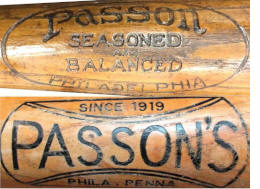 In 1927, Harry J. Passon, co-owner of
the Philadelphia based, PGB Sporting
goods company, established in 1919,
bought out his partners and re-named it
Passon's Sport Center.
Passion, became the sponsor and owner
of semi-pro and Negro Leagues teams.
In 1927, Harry J. Passon, co-owner of
the Philadelphia based, PGB Sporting
goods company, established in 1919,
bought out his partners and re-named it
Passon's Sport Center.
Passion, became the sponsor and owner
of semi-pro and Negro Leagues teams.
He bought and renovated a ballpark that became "Passon Field", which would
host
various Negro Leagues teams in the
1930s. He was instrumental in
challenging and overturning
Philadelphia's blue laws which
prevented the playing of baseball games
on Sundays.
Passon's baseball bats featured 4 different center brands through the
years including the in-store Gold
Brand Athletic Good label."
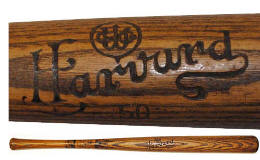 The
Harvard brand of baseball bats were
produced for the George Worthington
Company. The wholesale Hardware company
located in Cleveland, Ohio, was started
by a 16 year old George Worthington in
1829. The first hardware store was
opened in 1835 when he acquired a
competitor, McCurdy & Conklin.
The
Harvard brand of baseball bats were
produced for the George Worthington
Company. The wholesale Hardware company
located in Cleveland, Ohio, was started
by a 16 year old George Worthington in
1829. The first hardware store was
opened in 1835 when he acquired a
competitor, McCurdy & Conklin.
The advent of the railroad and the
Civil War stimulated the company's
growth. By 1870 the firm began issuing
yearly catalogs as sales reached $1.5
million, and incorporated in 1887. The
"GWCo." logo was used sometime around
the 1920's through to the 1940s. The
1922 Geo. Worthington Co. catalog
lists; the Harvard Professional Model,
Professional League, Special
League, and Boys Model, baseball bats.
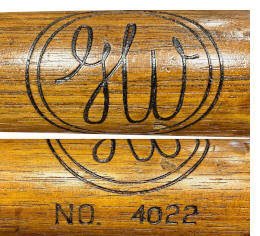 Great Western Athletic Goods of Chicago
was primarily a uniform manufacturer.
Thomas E. Wilson & Co. Athletic Goods
wanting to establish a niche in the
uniform market, merged with Great
Western in 1925.
Great Western Athletic Goods of Chicago
was primarily a uniform manufacturer.
Thomas E. Wilson & Co. Athletic Goods
wanting to establish a niche in the
uniform market, merged with Great
Western in 1925.
The company was renamed Wilson-Western Sporting Goods. Then in 1931,
changed to the Wilson Sporting Goods
Co. Wilson also produced Great Western
branded baseball equipment for the GW
catalog.
The Great Western Circuit Drive "Pepperized" baseball bats were
Professional style duplicates of player
models, featuring BLOCK LETTER
endorsements of players under contract
with Louisville Slugger. This and the "Pepperized"
stamping, similar to "Powerized"
Suggests that the Hillerich & Bradsby
Co. manufactured the bats.
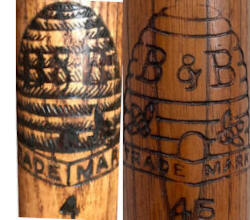 There is little known about the origin
of the B & B baseball bats, with the
Trademark Beehive logo. The label does
not indicate the type of store
(sporting goods, discount, department,
or hardware), company information, or
location.
There is little known about the origin
of the B & B baseball bats, with the
Trademark Beehive logo. The label does
not indicate the type of store
(sporting goods, discount, department,
or hardware), company information, or
location.
B
& B baseball bats that have
surfaced in the hobby include a "League
Regulation" decal on the barrel. The
Hillerich & Bradsby Co., used the same
decal on the No.13 "King of the Field"
line.
This suggests that the bats were most likely manufactured by Louisville
Slugger. There are two variations of
the beehive, one with the beehive
entrance darken, one bee, a vertical
line separating "Trade l Mark" among
other differences. |
|
| |
|
|
| |
 |
|
| |
This baseball bat was made for
Crowley-Milner and Company, a major
department store chain founded in
Detroit, Michigan, in 1909. They
carried a full line of baseball
equipment made by major manufactures. The simple branding on this bat reads; "Crowley Milner & Co., De troit
Michigan" and cannot be attributed to
any major manufacturer.
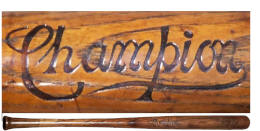 The
"Champion" baseball bats are a
generic brand that were sold in drug
and discount stores, from about 1930 to
1962. There are no manufacture
trademarks, so it would be close to
impossible to identify the maker. All
the newspaper ads found were taken out
in
The
"Champion" baseball bats are a
generic brand that were sold in drug
and discount stores, from about 1930 to
1962. There are no manufacture
trademarks, so it would be close to
impossible to identify the maker. All
the newspaper ads found were taken out
in
California, and one in Oregon,
indicating that the bats were turned in
a woodworking shop located in
California. The Bat was first made
during the Great Depression of the
1930s. Many woodworking companies
produced baseball bats to add extra
income to make up for the poor economy. |
|
| |
|
|
| |
Also Read:
Lesser-Known and Privately Branded
Baseball Bat Labels Part I
Lesser-Known and Privately Branded
Baseball Bat Labels Part II |
|
| |
|
|
| |
There are hundreds of privately
branded baseball bats labeled by a
large variety of businesses that
include manufacturers of furniture, and
tool handles, to retail stores
promoting their business such as shoe
stores, hardware, discount and
department stores. These bats will be
cataloged in the
Vintage Baseball
Bat Dating Guide on the website, in
Misc. & Private branded baseball
Bats. If you have a bat that you
can't identify, and it wasn't
added to the guide, send some
pictures to
Steve@keymancollectibles.com.
|
|
| |
|
|
| |
KEYMAN COLLECTIBLES
RELATED RESOURCES |
|
| |
|
|
| |
KeyMan
Collectibles Collectors Corner
- Keep up with the latest collecting news,
announcements, and articles of interest on the
webs best resource for baseball memorabilia. |
|
| |
KeyMan Collectibles Baseball
Memorabilia Facebook Group -
Post Questions and comments relating to
Baseball Collectibles and Memorabilia. Interact
with other collectors or show off your
collection. |
|
| |
KeyMan Collectibles Forum
- A great option for those that "Don't do
facebook" Post Questions and
comments relating to Baseball Collectibles and
Memorabilia |
|
|

